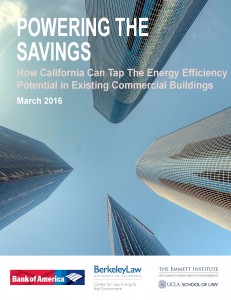 California has an aggressive goal to double the energy efficiency of existing buildings by 2030. The problem though is that building owners don’t seem very interested in having energy retrofit work done on their house or commercial property. We covered this subject in a recent Berkeley/UCLA Law report Powering the Savings, as well as in a September panel event at Berkeley Law.
California has an aggressive goal to double the energy efficiency of existing buildings by 2030. The problem though is that building owners don’t seem very interested in having energy retrofit work done on their house or commercial property. We covered this subject in a recent Berkeley/UCLA Law report Powering the Savings, as well as in a September panel event at Berkeley Law.
A reporter from E&E News attended that event and interviewed a few of us afterwards. Her article (paywalled) described some of the challenges:
The price tag for California’s goal is extremely high. Retrofitting all owner-occupied housing units in California — half of all housing — would cost $180 billion, DeVries estimated. There have been about $4.5 billion worth of retrofits under PACE programs nationwide, mostly in California. “I don’t think we’re going to find the money here,” he said. “We’re going to have to find it elsewhere, which means Wall Street, which means securitizations.”
Wall Street has the appetite, according to DeVries. His company’s latest offering of $220 million in project-backed bonds saw four times more demand than the available supply. The problem is consumer demand. “You can have all the investor interest in the world, and it doesn’t matter one bit,” he said. “The chicken and the egg here — the demand has to come first.”
Figuring out easy, capital market-type financing could help drive this demand, as we’ve seen with rooftop solar. And finding ways to reach building owners during key moments is also important, like when they’re between tenants or when remodeling or appliance replacements are in the works. But at some point, the state may need to move toward mandatory retrofit requirements during times of change in ownership or tenancy, as other jurisdictions have done.
Without these steps, what should be one of the most cost-effective ways to fight climate change may continue to under-perform and under-deliver.


